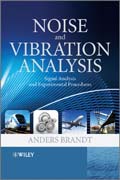
Noise and vibration analysis: signal analysis and experimental procedures
Brandt, Anders
INDICE: Preface List of Abbreviations List of Symbols 1 Introduction 1.1 Noise and Vibration 1.2 Noise and Vibration Analysis 1.3 Application Areas 1.4 Analysis of Noise and Vibrations 1.5 Standards 1.6 Becoming a Noise and Vibration Analysis Expert 2 Dynamic Signals and Systems 2.1 Introduction 2.2 PeriodicSignals 2.3 Random Signals 2.4 Transient Signals 2.5 RMS Value and Power 2.6 Linear Systems 2.7 The Continuous Fourier transform 2.8 Chapter Summary 2.9 Problems References 3 Time Data Analysis 3.1 Introduction to Discrete Signals 3.2 The Sampling Theorem 3.3 Filters 3.4 Time Series Analysis 3.5 Chapter Summary 3.6 Problems References 4 Statistics and Random Processes 4.1 Introduction to the Use of Statistics 4.2 Random Theory 4.3 Statistical Methods 4.4 Quality Assessment of Measured Signals 4.5 Chapter Summary 4.6 Problems References 5 Fundamental Mechanics 5.1 Newton´s Laws 5.2 The Single Degree-of-Freedom System(SDOF) 5.3 Alternative Quantities for Describing Motion 5.4 Frequency Response Plot Formats 5.5 Determining Natural Frequency and Damping 5.6 Rotating Mass5.7 Some Comments on Damping 5.7.1 Hysteretic damping 5.8 Models Based on SDOF Approximations 5.9 The Two-Degree-of-Freedom System (2DOF) 5.10 The Tuned Damper 5.11 Chapter Summary 5.12 Problems References 6 Modal Analysis Theory 6.1Waves on a String 6.2 Matrix formulations 6.3 Eigenvalues and Eigenvectors 6.4 Frequency Response of MDOF Systems 6.5 Time Domain Simulation of Forced Response 6.6 Chapter Summary 6.7 Problems References 7 Transducers for Noise and Vibration Analysis 7.1 The Piezoelectric Effect 7.2 The Charge Amplifier 7.3 TransducersWith Built-In Impedance Converters, IEPE' 7.4 The Piezoelectric Accelerometer 7.5 The Piezoelectric Force Transducer 7.6 The Impedance Head 7.7 TheImpulse Hammer 7.8 Accelerometer Calibration 7.9 Measurement Microphones 7.10Microphone Calibration 7.11 Shakers for Structure Excitation 7.12 Some Comments on Measurement Procedures 7.13 Problems References 8 Frequency Analysis Theory 8.1 Periodic Signals - The Fourier Series 8.2 Spectra of Periodic Signals 8.3 Random processes 8.4 Transient Signals 8.5 Interpretation of spectra 8.6 Chapter Summary 8.7 Problems References 9 Experimental Frequency Analysis 9.1 Frequency Analysis Principles 9.2 Octave and Third-Octave Band Spectra 9.3 The Discrete Fourier Transform (DFT) 9.4 Chapter Summary 9.5 Problems References 10 Spectrum and Correlation Estimates Using the DFT 10.1 Averaging 10.2 Spectrum Estimators for Periodic Signals 10.3 Estimators for PSD and CSD 10.4 Estimator for Correlation Functions 10.5 Estimators for Transient Signals 10.6 Spectrum Estimation in Practice 10.7 Multi-Channel Spectral Analysis 10.8 Chapter Summary 10.9 Problems Refer
- ISBN: 978-0-470-74644-8
- Editorial: John Wiley & Sons
- Encuadernacion: Cartoné
- Páginas: 448
- Fecha Publicación: 18/02/2011
- Nº Volúmenes: 1
- Idioma: Inglés
